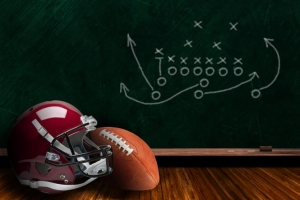
Every industry has its own jargon — its closely guarded insider terms that outsiders can’t and simply won’t understand. But there is a language that brings us all together. It’s football. Football terms find their way into every industry — seemingly every conversation. We’re going to punt on this project. Let’s huddle up and figure out a way to get this thing over the goal line. The terms translate well.
Truth is, we in fleet management use football terms as often as anybody. Managers “coach up” new workers. When we say we need to do an “end-around” or mobilize for a “two-minute drill,” everybody gets it.
All of which brings us to a discussion about how companies can improve performance in the “last mile.” Last mile is not a football term. Could that be the problem? We’ve done so well applying football terms to other areas of society, maybe we could solve the last-mile conundrum if we just wore down the defense with more football terms.
Here we go. We’ll kick off the discussion.
Entering the Red Zone
This is easy. The last mile is the Red Zone — the stretch inside a football opponent’s 20 yard line where your team is threatening to score. In daily distribution, the Red Zone is often more congested than the rest of the route. There’s a limited amount of time to make the delivery. A lot can go wrong. A driver needs technology to help him or her navigate successfully within the Red Zone. Omnitracs’ software can alert the driver when he or she enters a defined zone (can be a mile or two — doesn’t have to be 20 yards). It can furnish the driver with key information — like where to park in a certain locale and whom to ask for at the customer location. When you enter the Red Zone, you need to score. Technology will help get you six points.
Avoiding Turnovers
Interceptions and fumbles derail drives in football. Likewise, “turnovers” can complicate “drives” that reach distribution’s last mile. When you deliver product to a customer, you have to make sure that it’s fully accounted for and intact. Technology can play a role in ensuring that this happens. Using fleet management software, office personnel key in order details for each delivery in the office backend system. Order counts are often checked for accuracy at the customer site. Fleet management software communicates to the driver where to deliver product in the event an attendant is not on duty. Drivers also have the ability to take a picture on their mobile device to make sure the delivery is logged in the back-office system. And the back office can monitor driver performance using a telematics solution, making sure he’s not taking corners too tight or braking too hard.
Managing the Clock
Football coaches do their best to use the game clock to their advantage — slowing down drives when they’re ahead and speeding things up late in games if their team is behind. In last-mile delivery, routers and dispatchers try to manage their own time clocks to benefit not only the business but the workers themselves. Last-mile route optimization software does this. Managers consolidate information about the day’s deliveries and the system creates the most efficient routes. This ensures deliveries make it to their destinations on time, keeps drivers from having to work overtime, and increases overall customer satisfaction.
Staying in Bounds
In football, the play is over once the ball is carried, kicked, or thrown out of bounds. Preparing for last-mile deliveries, companies can implement programs to keep drivers “in bounds,” or, more specifically, on their routes. Drivers have some leeway to venture off route to grab a meal at a favored spot — but there are limits. Vehicle management system software tracks locations and distances traveled. If a driver heads 50 miles off route to hit a particular pizza shop, dispatchers can spot it and have a conversation in real time. Last-mile distribution, like football, requires discipline. Staying in bounds can keep gas costs in line and make sure deliveries get done on time.
Creating a Game Plan
Before every game, football coaches gather and assemble a plan to put their team in the best position to succeed. The plan is not written in stone days before the team takes the field. It gets edited and reedited, then finalized based on weather conditions and injuries. Distributors create their own game plans. They look at a variety of factors — like number of orders, locations of deliveries, conditions of trucks, and availability of drivers. But they can’t lock down the specifics until “game day.” Food and beverage orders often come the day before, so having a flexible system that optimizes routes gives distribution “coaches” an edge.
Calling an Audible
Having flexibility is one thing. Being able to change an order on the fly is quite another. On the football field, the coach picks a play, but then the quarterback is free to “call an audible” if he thinks he can exploit a defensive scheme. At a daily distributor, last-minute changes happen all the time. If a restaurant increases its order after the truck leaves the terminal, a dispatcher can update the order, find the closest truck with that product, and call the driver with the change — all in real time. If a customer needs to change a delivery along the same route — shifting a few cases from one customer to another — the dispatcher can update the plan and alert the driver on his mobile device.
Avoiding ‘Delay of Game’ Penalties
Nobody likes penalties — especially ones that, with a little preparation and common sense, can be avoided. In football, “delay of game” penalties cost a team five yards. In daily routing, delays can cost a company much more. Much of the responsibility rests with the routers and dispatchers. They need to budget enough time to get their drivers to a target destination. If a driver late for one delivery, chances are they’re going to be late for all of them. Distributors can help drivers manage situations by maintaining a rich trove of information on specific routes and specific drop-off locations. They can create and update route plans, keep detailed pointers on customer preferences (deliveries at Gate A in the morning, Gate B in the afternoon), and have customer contact information handy if a loading dock isn’t open.
Achieving a High QB Rating
One could argue that a football quarterback has more influence over a team’s performance than any other position in sports. To measure his performance, analytics pros have devised a “quarterback rating,” taking into account all kinds of measures of efficiency. Daily distributions companies use analytics to measure and improve the performance of their own sets of QBs — the drivers. Systems track each driver’s statistics dealing with with on-time deliveries, completing deliveries within the time allowed, avoiding accidents, time spent time idling the engine, fuel efficiencies achieved, and general safety records. Savvy operators use the numbers to promote skilled drivers, spot areas for training and implement fleet-wide initiatives to jump-start performance.
Playing Strong Safety
A “strong safety” in football plays defense. He’s primarily responsible for covering tight ends and stopping the run. Distribution companies can put an emphasis on “strong safety” by creating tight, disciplined safety programs that are bolstered by technology. Telematics solutions help companies track their two most important assets — people and equipment — to make sure both are operating as safely and efficiently as possible. They measure if the driver is following safety guidelines — avoiding dangerous behaviors such as speeding, idling, harsh cornering, and harsh braking. They track vehicle performance and can be set up to deliver alerts when a vehicle is due for maintenance.
